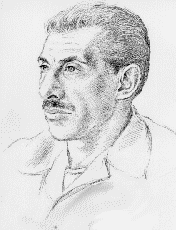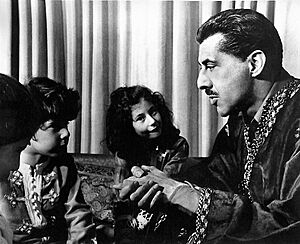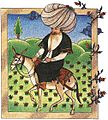Idries Shah facts for kids
Quick facts for kids
Idries Shah
|
|
|---|---|
 |
|
| Born | Idries Shah 16 June 1924 Simla, Punjab Province (British India) |
| Died | 23 November 1996 (aged 72) London, England, UK |
| Pen name | Arkon Daraul |
| Occupation | Writer, publisher |
| Genre | Eastern philosophy and culture |
| Subject | Sufism, psychology |
| Notable works |
|
| Notable awards | Outstanding Book of the Year (BBC "The Critics"), twice; six first prizes at the UNESCO World Book Year in 1973 |
| Spouse | Cynthia (Kashfi) Kabraji |
| Children | Saira Shah, Tahir Shah, Safia Shah |
| Signature | |
 |
|
Idries Shah (born June 16, 1924 – died November 23, 1996) was an Afghan author, thinker, and teacher. He was known for his work on Sufism, a special kind of wisdom. Shah wrote more than 30 books about many topics. These included psychology, spirituality, travel, and different cultures.
He was born in British India. His father's family were Afghan nobles, and his mother was Scottish. Idries Shah mostly grew up in England. In 1960, he started a publishing company called Octagon Press. This company published his own books and translations of old Sufi writings. His most important book, The Sufis, came out in 1964 and was very popular around the world. In 1965, he started the Institute for Cultural Research in London. This group studied human behavior and culture.
Idries Shah taught that Sufism is a universal wisdom. This means it's a kind of knowledge that can be helpful to everyone, no matter their background. He believed Sufism wasn't stuck in the past. It could always change to fit new times, places, and people. He often used old teaching stories and parables in his lessons. These stories had many layers of meaning. They were designed to help readers think deeply and understand themselves better. He is especially famous for his funny stories about a character called Mulla Nasrudin.
Some experts on Eastern cultures questioned his background. But many famous people, like the writer Doris Lessing, supported him. Idries Shah became known as an important voice for Sufism in the West. He gave talks at many universities. His books helped people see Sufism as a spiritual wisdom that anyone could learn from. It didn't have to be tied to a specific religion.
Idries Shah: A Life of Wisdom
Early Life and Family
Idries Shah was born in Simla, a city in British India. His father, Sirdar Ikbal Ali Shah, was an Afghan-Indian writer and diplomat. His mother, Saira Elizabeth Luiza Shah, was Scottish. His family on his father's side were Sayyids, which means they were descendants of the Islamic prophet Muhammad. Their family home was near Kabul, in Afghanistan. His grandfather was a nawab, a noble title, in India.
Shah spent most of his childhood near London, England. From a young age, he traveled a lot with his father. His father was involved in Sufi work, so Idries met many important people from both Eastern and Western cultures. This helped him gain a wide view of the world. He learned to understand different people and places.
Idries Shah described his own unique childhood in a 1971 interview. He said his family wanted him to experience many different things. They wanted him to meet all kinds of people. This was to help him become a well-rounded person. He called this the "Sufi approach" to learning.
In 1940, his family moved to Oxford to avoid German bombing during World War II. He went to the City of Oxford High School for Boys for a few years. In 1945, he went to Uruguay with his father. He worked as his father's secretary for a short time.
Personal Life
In 1958, Idries Shah married Cynthia (Kashfi) Kabraji. She was the daughter of an Indian poet. They had a daughter, Saira Shah, in 1964. Then, in 1966, they had twins: a son, Tahir Shah, and another daughter, Safia Shah.
Becoming a Writer and Publisher
In the late 1950s, Shah connected with groups interested in Wicca (a modern pagan religion) in London. For a while, he worked as a helper to Gerald Gardner, who founded modern Wicca. Shah also used to meet people interested in Sufism every Tuesday evening at a restaurant in London.
In 1960, Shah started his own publishing company, Octagon Press. One of its first books was a biography of Gerald Gardner. Shah actually wrote this book himself, but it was published under someone else's name. This was because he didn't want his Sufi students to be confused by his interest in other spiritual traditions.
In 1961, Shah met the famous English poet Robert Graves in Spain. Shah and Graves became close friends. Graves encouraged Shah to write a clear book about Sufism for Western readers. This book became The Sufis.
The Sufis was published in 1964. It talked about how Sufism influenced Western culture and traditions over many centuries. Shah's book was different because it avoided using terms that might link Sufism too closely to traditional Islam. He wanted to show Sufism as a universal wisdom. The book also had a special "scattered" writing style. Shah said this style was meant to help people think differently and break old habits.
What is Sufism?
Idries Shah taught that Sufism is a very old form of wisdom. It existed even before Islam. He stressed that Sufism is not rigid; it changes and adapts to different times, places, and people. He compared Sufi schools to waves hitting rocks. They are all from the same ocean, but they look different and serve the same purpose.
Shah often disagreed with how some scholars described Sufism. He felt that just studying its history wasn't enough to truly understand it. He believed that focusing too much on old forms could actually stop people from seeing what Sufism really is. He used a saying: "Show a man too many camels' bones, or show them to him too often, and he will not be able to recognise a camel when he comes across a live one." This meant that focusing on old details could make you miss the living truth.
Shah presented Sufism as a path that goes beyond individual religions. He made it easy for Western audiences to understand. He didn't focus on religious rituals. Instead, he showed Sufism as a way to understand yourself better, like a kind of psychology. He believed that people could develop new ways of understanding things. He said that human beings are always evolving.
Shah believed that talking about God wasn't very useful if people couldn't understand deeper truths first. He told a story about an ant who thought God must be like a giant ant with two stings instead of one. This showed how people often imagine God to be just a bigger version of themselves.
Spreading Ideas in the West
In 1965, Shah started The Institute for Cultural Research (ICR). This group aimed to encourage study and discussion about human thought and culture. His home, Langton House, became a meeting place for writers, thinkers, and leaders from all over the world. The ICR held meetings and lectures there.
Shah also used his publishing company, Octagon Press, to print many classic Sufi books. He collected, translated, and wrote thousands of Sufi stories. These stories helped Western audiences learn about Sufi wisdom. Many of his books featured the funny character Mullah Nasruddin. Shah explained that these stories, often seen as folklore, were actually Sufi parables.
In 1970, Shah made a TV show for the BBC called Dreamwalkers. It featured Mullah Nasruddin and discussed how humor and old stories could help people think differently. The show ended with Shah saying that humans could improve themselves by "breaking psychological limitations." He asked, "Man is asleep – must he die before he wakes up?"
Shah also set up Sufi study groups in the United States. He worked with American psychologists like Robert Ornstein. Ornstein became a key person for Shah's work in the U.S. He helped publish Shah's books and spread his ideas.
The Gurdjieff Connection (Simplified)
In 1962, Shah also connected with people who followed the teachings of Gurdjieff, another spiritual teacher. One of Gurdjieff's early students, John G. Bennett, believed that Gurdjieff's teachings had Sufi roots. Bennett met Shah and felt that Shah had important knowledge to share.
Shah explained that his work was about finding people who could gain special knowledge. He wanted to group them in a way that helped them learn and grow. He said that Sufism was not a mystical system or a religion, but a "body of knowledge." He wanted to make this knowledge useful to people in the West. He believed that people needed to understand psychology first, before they could truly understand spirituality.
Teaching Through Stories
Shah used teaching stories and humor a lot in his work. He believed these surprising stories could help people see things in new ways. Reading and discussing these stories in groups was an important part of his study circles.
Stanford University psychology professor Robert Ornstein studied how these stories could change a student's way of thinking. Ornstein, along with other famous writers like Ted Hughes and Doris Lessing, was greatly influenced by Shah.
Shah explained that Sufi stories are like a peach. You can enjoy the outside, eat the fruit, and then crack the pit to find a delicious kernel inside. This kernel is the hidden, deeper meaning. If you only see the story as funny or simple, you miss the true wisdom.
His son, Tahir Shah, wrote about his father's storytelling. He said his father always had a story ready to share an idea. He believed that old Eastern story collections were like encyclopedias of wisdom. They were complex psychological documents, full of knowledge passed down for ages.
Idries Shah explained that these stories are like "technical documents" or "maps." He said people had forgotten how to use these maps. He compared it to a beautiful chessboard found after centuries. People would admire it, but not know it was for a game. He said his job was to show people how to "play" with the stories again, to find their inner value.
Later Life and Legacy
Over the next few decades, Shah wrote about 20 more books. Many of them used classic Sufi sources. His writings became very popular worldwide, especially with educated Western readers. He translated Sufi ideas into modern language, making them easy to understand. His folktales, which showed Sufi wisdom through short examples, were especially liked.
Shah was invited to give talks as a visiting professor at many universities around the world. Besides writing and teaching, he also designed an air ioniser and ran several businesses. He traveled to his family's home country, Afghanistan, and helped with relief efforts there. He used these experiences in his novel Kara Kush, which was about the Soviet–Afghan War.
In 1987, Shah had two serious heart attacks. Doctors said he wouldn't live long. But he kept working for nine more years, writing more books despite his illness.
Idries Shah passed away in London on November 23, 1996, at age 72. He was buried in Brookwood Cemetery. At the time of his death, his books had sold over 15 million copies in many different languages.
Idries Shah believed his books were his most important legacy. He thought they would continue his work even after he was gone. His students helped promote and share his books. In 2013, a new charity called The Idries Shah Foundation was created to continue his work.
When asked what he wanted for humanity, Shah said he wished people would study the findings of psychological research from the last 50 years. He wanted this knowledge to become part of everyone's way of thinking.
His brother, Omar Ali-Shah, was also a Sufi teacher. His daughter, Saira Shah, became known for her documentary Beneath the Veil, about women's rights in Afghanistan. His son, Tahir Shah, is a famous travel writer.
Translations
Idries Shah's books have been translated into many languages, including French, German, Spanish, and Turkish.
His Books
Books on Ancient Beliefs
- Oriental Magic (1956)
- The Secret Lore of Magic (1957)
Books on Sufism
- The Sufis (1964)
- Tales of the Dervishes (1967)
- Reflections (1968)
- The Way of the Sufi (1968)
- Thinkers of the East: Studies in Experientialism (1971)
- Learning How to Learn (1978)
- The Commanding Self (1994)
Mulla Nasrudin Stories
- The Exploits of the Incomparable Mulla Nasrudin (1966)
- The Pleasantries of the Incredible Mulla Nasrudin (1968)
- The Subtleties of the Inimitable Mulla Nasrudin (1973)
Other Writings
- Destination Mecca (Travel, 1957)
- Kara Kush (Fiction, 1986)
- World Tales (Folklore, 1979)
Images for kids
See also
- The Institute for Cultural Research (1965–2013)
- The Idries Shah Foundation (2013 onwards)




